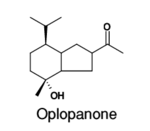Oplopanax japonicus
Oplopanax japonicus is deciduous shrub that can grow as high as 3 m (9.8 ft) tall. The plant is densely packed with spikes and those spikes are irritant. This species of plant belongs to a genus that is rich in calcium oxalate, which is toxic to the digestive system.[1]
| Oplopanax japonicus | |
|---|---|
| An Oplopanax japonicus plant in Japan | |
| Scientific classification | |
| Kingdom: | Plantae |
| Clade: | Tracheophytes |
| Clade: | Angiosperms |
| Clade: | Eudicots |
| Clade: | Asterids |
| Order: | Apiales |
| Family: | Araliaceae |
| Genus: | Oplopanax |
| Species: | O. japonicus |
| Binomial name | |
| Oplopanax japonicus Nakai | |
Distribution
Oplopanax japonicus is naturally found in East Asia, specifically in Japan.[2] It is usually found in the coniferous shady forest of Northern Japan.[3] One species is also found in China and North America.[4]
Habitat and ecology
Oplopanax japonicus grow in woodland garden and dappled shade, shady edge and not in deep shade.The optimal cultivation environment is a moist, well drained and retentive soil.[5]
Morphology
Oplopanax japonicus is a hardy frost resistant shrub. It is also the most spiny member of the ginseng family. It forms seldom and randomly branched stems that are approximately 1 m (3 ft 3 in) long. Deciduous, can grow up to 3 m (9.8 ft) tall, Branches bulky, with solid yellow-orange prickles. The stem is prickly and stocky. Petiole 3–10 cm (1.2–3.9 in), densely covered with setae. The leaf blade approximately circular to oblate, the leaf is approximately 15–30 cm (5.9–11.8 in) wide, the two surfaces are usually 5–7 lobed. The shape of the lobe is triangular or broadly triangular, base cordate, margin irregularly serrate, apex acute to slightly acuminate.[6] They have ornamental qualities but are armed with spikes. The plant also features spiny leaves and stems.[7]
Flowers and fruit
Flowers of Oplopanax japonicus, is usually hermaphrodite (having both male and female organs).[8] Inflorescence terminal, a raceme of umbels, length of 8–25 cm (3.1–9.8 in), densely covered with setae towards the bae, stiffly covered with tiny hairs throughout; umbels length of 0.9–1.3 cm (0.35–0.51 in) in diameter. Usually 6–12 flower with proximal peduncles that is 2.5 cm (0.98 in) long. Calyx 5-toothed and glabrous. Styles united to middle, slender and apical. Fruit yellow-red at maturity, and sometimes globose.[9]
Food
The leaves and roots of Oplopanax japonicas can be used as food. Young shoots have to be thoroughly peeled and cooked for eating. Roots can be cooked or chewed.[10]
Herbal medicine
Oplopanax japnicus is used in herbal medicine.[11] A sesquiterpene has been isolated and a synthetic derivative of the ketone form has been commercially produced in Japan to treat cough.[12]
Chemical constituents

An example of a sesquiterpene that has been isolated and characterized is oplapanone.[13]
References
- "Oplopanax japonicus - (Nakai.)Nakai". Retrieved 9 April 2012.
- Huang, Wei-Hua; Qing-wen Zhang (23 February 2010). "Isolation and Identification of Two New Polyynes from a North American Ethnic Medicinal Plant--Oplopanax horridus (Smith) Miq". Molecules. 15: 1089–1096. doi:10.3390/molecules15021089.
- "Oplopanax (Araliaceae)". Retrieved 30 April 2012.
- Flora of China. Science Press (Beijing) and Missouri Botanical Garden Press. 2007. pp. 436–437, 441.
- "Oplopanax (Araliaceae)".
- "Aussiee Gardening- Oplopanax japonicus". Retrieved 9 April 2012.
- "My Garden- Oplopanax japonicus". Retrieved 9 April 2012.
- "Oplopanax japonicus". Retrieved 9 April 2012.
- "Oplopanax" (PDF). Harvard University Press. Retrieved 2012-04-27.
- "Herbal Databse - Oplopanax Japonicus". Retrieved 9 April 2012.
- "Plant of the Month". Retrieved 9 April 2012.
- Small, Ernest (1999). Canadian Medicinal Crops. National Research Council of Canada. ISBN 0-660-17534-7.
- Takeda, Ken'ichi; H. Minato; M. Ishikawa (1966). "Studies on sesquiterpenoids—XII: Structure and absolute configuration of oplopanone, a new sesquiterpene from oplopanax japonicus (NAKAI) NAKAI". Tetrahedron. 22: 219–225. doi:10.1016/s0040-4020(01)99108-2.
External links

